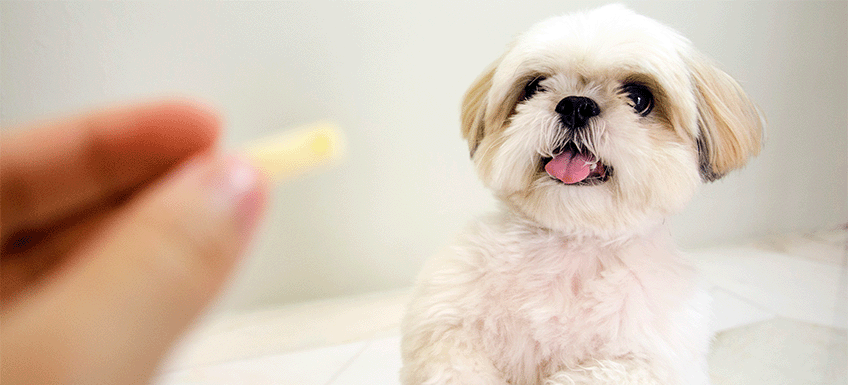
Tips for Giving Your Dog Treats
Dog
Diet and Nutrition
15/05/2023
Dog treats are a great way to reward your dog’s good behaviour or to just show a little more affection to your pooch. As fun as treats can be, it’s important for dog owners to know how quickly calories from dog treats can add up and result in your pet gaining weight. Maintaining a balance is key - keep it healthy while making it enjoyable and delicious.
Here are a few basic tips for giving your dog treats.
1. Maintain the 10% dog treat rule
Know when enough is enough. No matter what sort of treats you choose to feed your pet, there is such a thing as too much of a good thing.
Dog treats and snacks should only make up 10% of your pet’s daily diet. Your dog's daily food intake will vary depending on its activity level, size, and breed. Use dog treats to supplement your pet’s existing diet and not as a replacement for your pet’s meals.
Keep track of your dog's daily intake by buying dog treats that have a calorie count on the packaging and if you get large dog treats, think about breaking them apart and giving your dog the treat in smaller pieces throughout the day.
2. Pick healthy dog treats
When looking for dog treats look for those made with healthy, natural ingredients. Although treats formulated especially for dogs are designed so they are tasty and don’t upset dogs' stomachs, some have more fats and sugars than others that can contribute to unhealthy weight gain.
Avoid treats that are loaded with fats and sugars and read the label for ingredients before making a purchase.
A treat made with natural meats and whole grains is a good choice. Look for real meat and not a by-product, ideally hormone-free. If your pet has a grain allergy there are plenty of healthy options available.
3. Treat your dog with human foods
There are some great healthy ‘human foods’ that also make great healthy dog treats.
Most dogs love Peanut Butter! You can give it to them as is or make easy homemade dog treats. Make sure to pick peanut butter with no added salt, sugars, or artificial sweeteners.
A frozen dog treat wouldn’t go amiss either! Try stuffing the Kong Wobbler dog toy with peanut butter or a mix of other human foods that dogs can eat and freezing it for a few hours.
Other human foods that are safe for dogs to eat include;
- Apples (minus the core, apple seeds can be toxic to pets)
- Blueberries
- Watermelon (minus the seeds)
- Bananas
- Green beans
- Carrots
- Sweet potato
- Plain cooked meat or fish (chicken, pork or beef, lamb)
- Plain popcorn
Although the above foods are ok for dogs to eat, it's important to remember there are some human foods that are toxic to dogs and should be avoided. Foods such as chocolates, grapes, and pitted fruits like cherries, avocado, plums.
4. Sneak in healthy
Treats don’t just make our pets happy, they can also keep them healthy. Try to find treats that not only taste good but offer health benefits also. Dental dog treats are a great way to work tartar off of your pet’s teeth, and treats with glucosamine and taurine are perfect for maintaining aging animals' joints and organs.
Other health considerations could be dog treats to help with their joints or digestion. Use the filter function when searching for dog treats specific to your dog's needs. When choosing a treat that has supposed health benefits, look for reputable brands.
5. Watch for food sensitivities
10 percent of allergy causes for dogs are due to foods, and grains are one of the leading allergens. Other common allergy-triggering foods include eggs and dairy.
Look for excessive itching, flatulence, ear inflammation, and gastrointestinal upset as indicators of allergic issues, and speak to your vet. If your dog is one of those with a grain intolerance, as mentioned above there are grain-free options available that are perfect for pets with sensitivities.
6. Treat them without using food
There are so many ways to spoil your dog without food. They will feel loved if you simply give them extra cuddles and pats, take them to a park, or on a walk they love. You could play their favourite game or buy them a new dog toy!
Cater the type of reward you do to the type of activity you have planned. For example, if you are training, use a combination of small treats, praise, and playtime with a favourite toy.
7. The smellier the dog treat the better
When it comes to selecting dog treats - think like a dog! One of the dog’s strongest senses is their sense of smell. So in a dog’s brain smelly treats are yummy treats.
Treats that have a strong odor are especially effective when working on training your dog in difficult or distracting situations. When it comes to smelly treats dogs often love freeze-dried natural meat-based treats such as livers, hearts, or bully sticks as they are extra enticing.
8. Mix it up with a variety of dog treats
Just like us, our pets get bored of eating the same thing all the time. It is best to find a variety of different healthy dog treats that your pup enjoys and mix them up regularly. Especially if these treats are used for training, as by keeping it fresh your dog will continue to be interested and excited to work for its reward
When to give your dog a treat
There’s no rule as to how often you can give your dog treats, it is the amount you should limit. Using the 10% of daily intake rule, the rest is up to you.
How to give dog treats
- Hold the treat at the dog's eye level. People often naturally hold treats high up in the air which encourages dogs to jump up to try to get the treat.
- If you have an issue with your dog trying to snatch treats out of your hand, keep the treat in a closed fist until it is bought down to eye level.
- And when you are ready to offer it do so with a flat and open hand.
- This helps to keep your fingers out of the way and prevent any accidental nipping.
Have fun giving treats to your dog, but remember to keep it as just that: a treat.

Written by The Pet.co.nz
Team
Written by The Pet.co.nz Team
A team of specialists with backgrounds in animal nursing, animal care, and all things pet related.